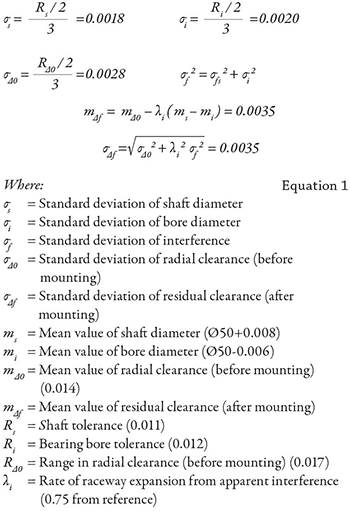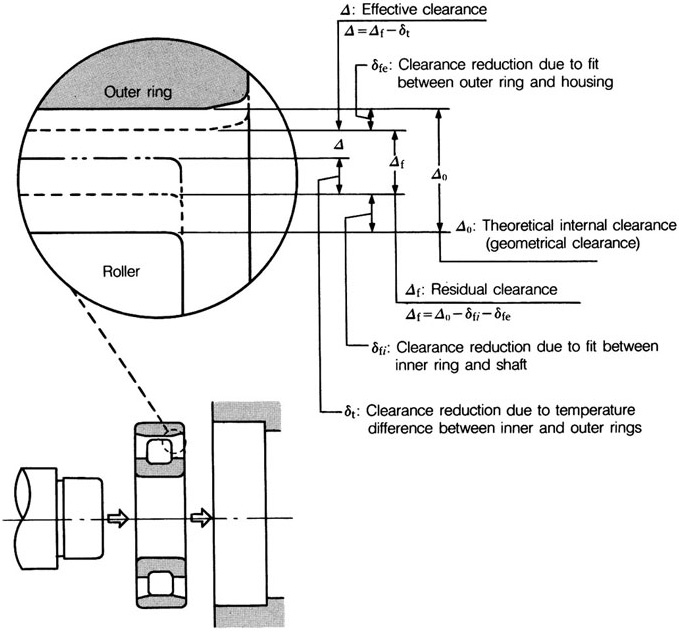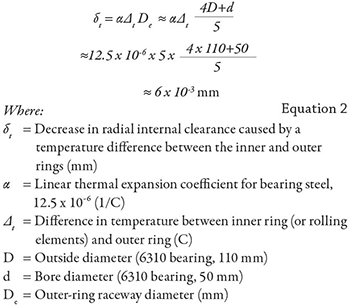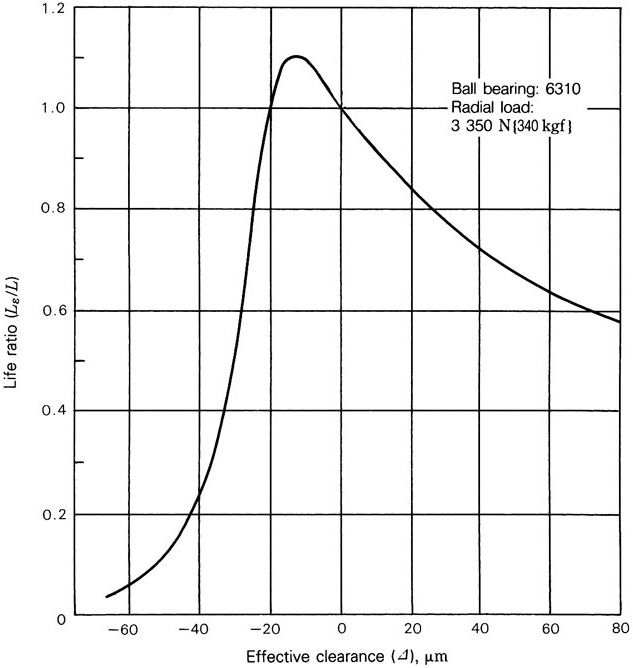The bearing internal clearance is the relative movement of the outer and inner rings when they are lightly pushing in opposite directions. Movement in the diametrical direction is radial clearance, while movement in the shaft’s direction is axial clearance.
Internal clearance is critical to bearing performance for multiple reasons. The amount of clearance influences the load distribution in a bearing, which ultimately affects its life. It also influences bearing running noise and vibration. In addition, it can influence whether the rolling elements move by rolling or sliding motion.
Normally, bearings are installed with an interference fit for either the inner or outer ring. This leads to expansion (inner ring) or contraction (outer ring), which causes a change in the internal clearance of the bearing after the assembly process. When the unit is running, the bearing's generic operating temperature may increase until it reaches a saturation temperature where the heat generation and heat rejection of the system are balanced.

While we typically use this generic operating temperature for the entire bearing, the actual temperature of the inner ring, outer ring and rolling elements may vary significantly.
This temperature difference can cause changes in the internal clearance as shown in Image 1. In addition, when a bearing operates under load, an elastic deformation of the inner ring, outer ring and rolling elements also leads to a change in clearance. Quantifying all of these changes can make calculating bearing internal clearance a complex task. Following are definitions of types of clearances.
 Image 1. Changes of radial internal clearance of roller bearing (Images courtesy of NSK)
Image 1. Changes of radial internal clearance of roller bearing (Images courtesy of NSK)Measured Internal Clearance (∆1)
This is the internal clearance measured under a specified measuring load, and can be called “apparent clearance.” This clearance includes the elastic deformation (бFO) caused by the measuring load.
∆1 = ∆0 + бFO
Theoretical Internal Clearance (∆0)
This is radial internal clearance, which is the measured clearance minus the elastic deformation caused by the measuring load.
∆0 = ∆1 + бFO
бFO is significant for ball bearings, but not for roller bearings where it is assumed to be zero, and therefore ∆0 = ∆1
Residual Internal Clearance (∆f)
This is the clearance in a bearing after it is mounted on a shaft and in a housing. The elastic deformation caused by the mass of the shaft is neglected. Assuming the clearance decrease caused by the ring expansion or contraction is бf, then:
∆f = ∆0 + бf
Effective Internal Clearance (∆)
This is the bearing clearance that exists in a machine at its operating temperature, excluding the elastic deformation caused by load. This is the clearance when considering only the changes due to bearing fitting бf and temperature difference between the inner and outer rings бt. The basic load ratings of bearings apply only when the effective clearance ∆=0.
∆ = ∆f – бt = ∆0 –(бf + бt)
Operating Clearance (∆F)
This is the actual clearance when a bearing is installed and running under load. Here, the effect of elastic deformation бF is included along with fitting and temperature. Generally, the operating clearance is not used in the calculation.
∆F = ∆ + бF
The most important bearing clearance is the effective clearance. Theoretically, a bearing with a slightly negative effective clearance ∆ will have the longest life. A slightly negative clearance (or preload) will become positive under the influence of bearing load. However, it is impossible to make the clearance of all bearings reach the ideal effective clearance, and one must consider the geometrical clearance ∆0 in order to achieve a zero or slightly negative effective clearance minimum value. To calculate this value, one needs to know both the clearance reduction caused by the interference of the inner ring and outer ring Df and clearance change caused by the temperature difference between inner ring and outer ring Dt.
Calculating Residual Internal Clearance after Mounting
When the inner ring of a bearing is press fit onto a shaft, or when the outer ring is press fit into a housing, the radial internal clearance will naturally decrease due to the resulting expansion or contraction of the bearing raceways. Generally, most pumps have a rotating shaft that requires a tight fit between the inner ring and shaft and a loose fit between the outer ring and housing. In these cases, only the effect of the interference on the inner ring needs to be considered.
An example calculation is shown in Equation 1 for a 6310 single row deep groove ball bearing. The shaft tolerance used is K5, while the housing is H7. The interference fit is applied only to the inner ring.
Shaft diameter, bore size and radial clearance are the standard bearing measurements. Assuming that 99.7 percent of the parts are within tolerance, the mean value (m∆f) and standard deviation (σ∆f) of the internal clearance after mounting (residual clearance) can be calculated. Measurements are given in units of millimeters (mm).
The average amount of raceway expansion and contraction from apparent interference is calculated from
λi (mm – mi).
The following equation is used to determine, within 99.7 percent probability, the variation in internal clearance after mounting (R∆f):
R∆f = m∆f ± 3σ∆f = +0.014 to -0.007
The mean value of residual clearance (m∆f) is +0.0035, and the range is from -0.007 to 0.014 for a 6310 bearing.
Radial Internal Clearance & Temperature
When a bearing runs under a load, the temperature of the entire bearing will rise. This includes the rolling elements. But because this change is difficult to measure or even estimate, the temperature of the rolling elements is generally assumed to be the same as the inner-ring temperature.

Using a 6310 bearing again as an example, the reduction in clearance caused by a temperature difference of 5 C between the inner and outer rings can be calculated using Equation 2.
Ball bearings: De = (4D + d) / 5
Roller bearings: De = (3D + d) / 4
Equation 3
Equation 3 is used to calculate the outer-ring raceway diameter. Using the values calculated for ∆f and бt, the effective internal clearance (∆) can be determined using the following Equation 4.
D = Df – dt = (+0.014 to -0.007) – 0.006 = +0.008 to -0.013
Equation 4
Image 2 shows how the effective internal clearance influences bearing life, in this example, with a radial load of 3,350 N (or approximately 5 percent of the basic load rating). The longest bearing life occurs under conditions where the effective internal clearance is -13 μm. The lowest limit to the preferred effective internal clearance range is also -13 μm.
 Image 2. Relation between effective clearance and bearing life for 6310 ball bearing
Image 2. Relation between effective clearance and bearing life for 6310 ball bearingApplication
While targeting a slightly negative clearance is optimal for bearing life in theory, in practice one must be careful when designing or building a pump with the bearing in a preload condition.
As shown in Image 2, the Life Ratio does peak at -13 μm, but drops dramatically with additional preload. Incorrect assumptions regarding machining tolerances or operating temperatures can easily result in a shorter life than anticipated if the bearing becomes preloaded too heavily. On the other hand, too much clearance can result in bearing noise, rolling element skidding and poor pump performance. One must evaluate the trade-offs of clearance and bearing preload based on the needs of the application.
Understanding the importance of bearing internal clearance will help increase bearing life and optimize your overall pump performance.


